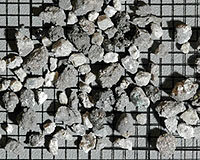 |
Santa Cruz CA (SPX) Nov 12, 2010 A bulge of elevated topography on the farside of the Moon - known as the lunar farside highlands - has defied explanation for decades. But a new study led by researchers at the University of California, Santa Cruz, shows that the highlands may be the result of tidal forces acting early in the Moon's history when its solid outer crust floated on an ocean of liquid rock. Ian Garrick-Bethell, an assistant professor of Earth and planetary sciences at UC Santa Cruz, found that the shape of the Moon's bulge can be described by a surprisingly simple mathematical function. "What's interesting is that the form of the mathematical function implies that tides had something to do with the formation of that terrain," said Garrick-Bethell, who is the first author of a paper on the new findings published in the November 11 issue of Science. The paper describes a process for formation of the lunar highlands that involves tidal heating of the Moon's crust about 4.4 billion years ago. At that time, not long after the Moon's formation, the crust was decoupled from the mantle below it by an intervening ocean of magma. As a result, the gravitational pull of the Earth caused tidal flexing and heating of the crust. At the polar regions, where the flexing and heating was greatest, the crust became thinner, while the thickest crust would have formed in the regions in line with the Earth. This process still does not explain why the bulge is now found only on the farside of the Moon. "You would expect to see a bulge on both sides, because tides have a symmetrical effect," Garrick-Bethell said. "It may be that volcanic activity or other geological processes over the past 4.4 billion years have changed the expression of the bulge on the nearside." The paper's coauthors include Francis Nimmo, associate professor of Earth and planetary sciences at UCSC, and Mark Wieczorek, a planetary geophysicist at the Institut de Physique du Globe in Paris. The researchers analyzed topographical data from NASA's Lunar Reconnaissance Orbiter and gravitational data from Japan's Kaguya orbiter. A map of crustal thickness based on the gravity data showed that an especially thick region of the Moon's crust underlies the lunar farside highlands. The variations in crustal thickness on the Moon are similar to effects seen on Jupiter's moon Europa, which has a shell of ice over an ocean of liquid water. Nimmo has studied the effects of tidal heating on the structure of Europa, and the researchers applied the same analytical approach to the Moon. "Europa is a completely different satellite from our moon, but it gave us the idea to look at the process of tidal flexing of the crust over a liquid ocean," Garrick-Bethell said. The mathematical function that describes the shape of the Moon's bulge can account for about one-fourth of the Moon's shape, he said. Although mysteries still remain, such as what made the nearside so different, the new study provides a mathematical framework for further investigations into the shape of the Moon. "It's still not completely clear yet, but we're starting to chip away at the problem," Garrick-Bethell said.
Share This Article With Planet Earth
Related Links University of California, Santa Cruz Mars News and Information at MarsDaily.com Lunar Dreams and more
 New type of moon rock identified
New type of moon rock identifiedProvidence, R.I. (UPI) Nov 3, 2010 U.S. scientists say a new type of rock on the moon, the first new variety identified in decades, is probably ancient material born deep inside the moon. Located on the far side of the moon and undetected until a space probe measured its odd mineralogy, the rocks are located in a few isolated deposits, ScienceNews.org reported Wednesday. "These are very unusual areas," Carle Piete ... read more |
|
| The content herein, unless otherwise known to be public domain, are Copyright 1995-2010 - SpaceDaily. AFP and UPI Wire Stories are copyright Agence France-Presse and United Press International. ESA Portal Reports are copyright European Space Agency. All NASA sourced material is public domain. Additional copyrights may apply in whole or part to other bona fide parties. Advertising does not imply endorsement,agreement or approval of any opinions, statements or information provided by SpaceDaily on any Web page published or hosted by SpaceDaily. Privacy Statement |